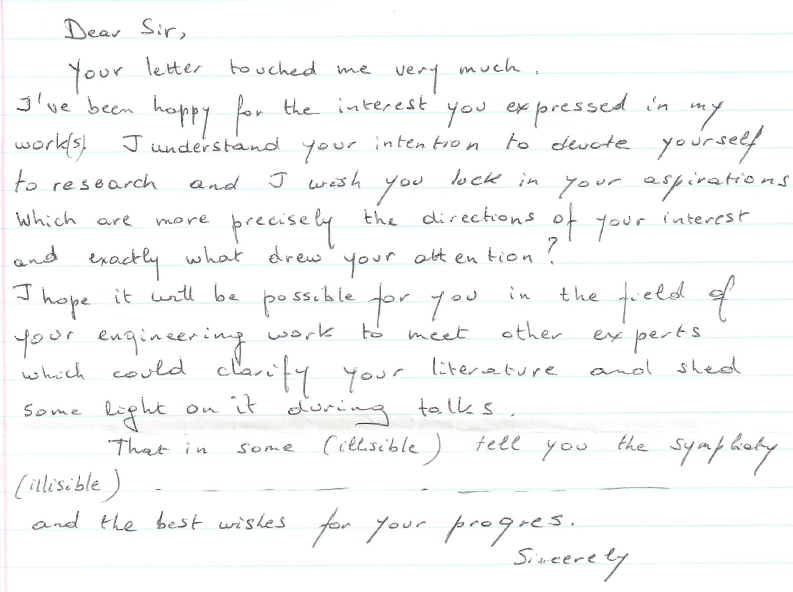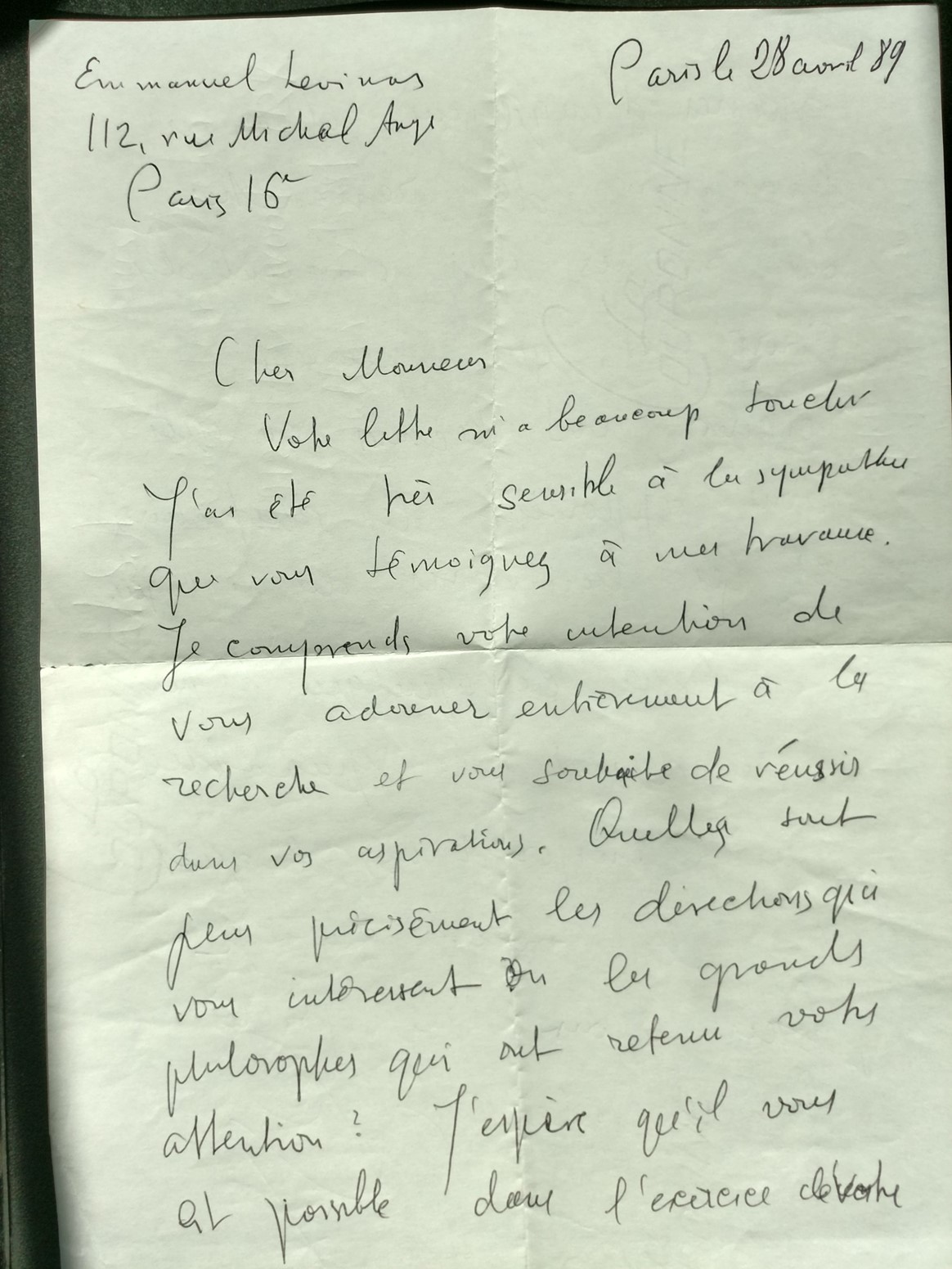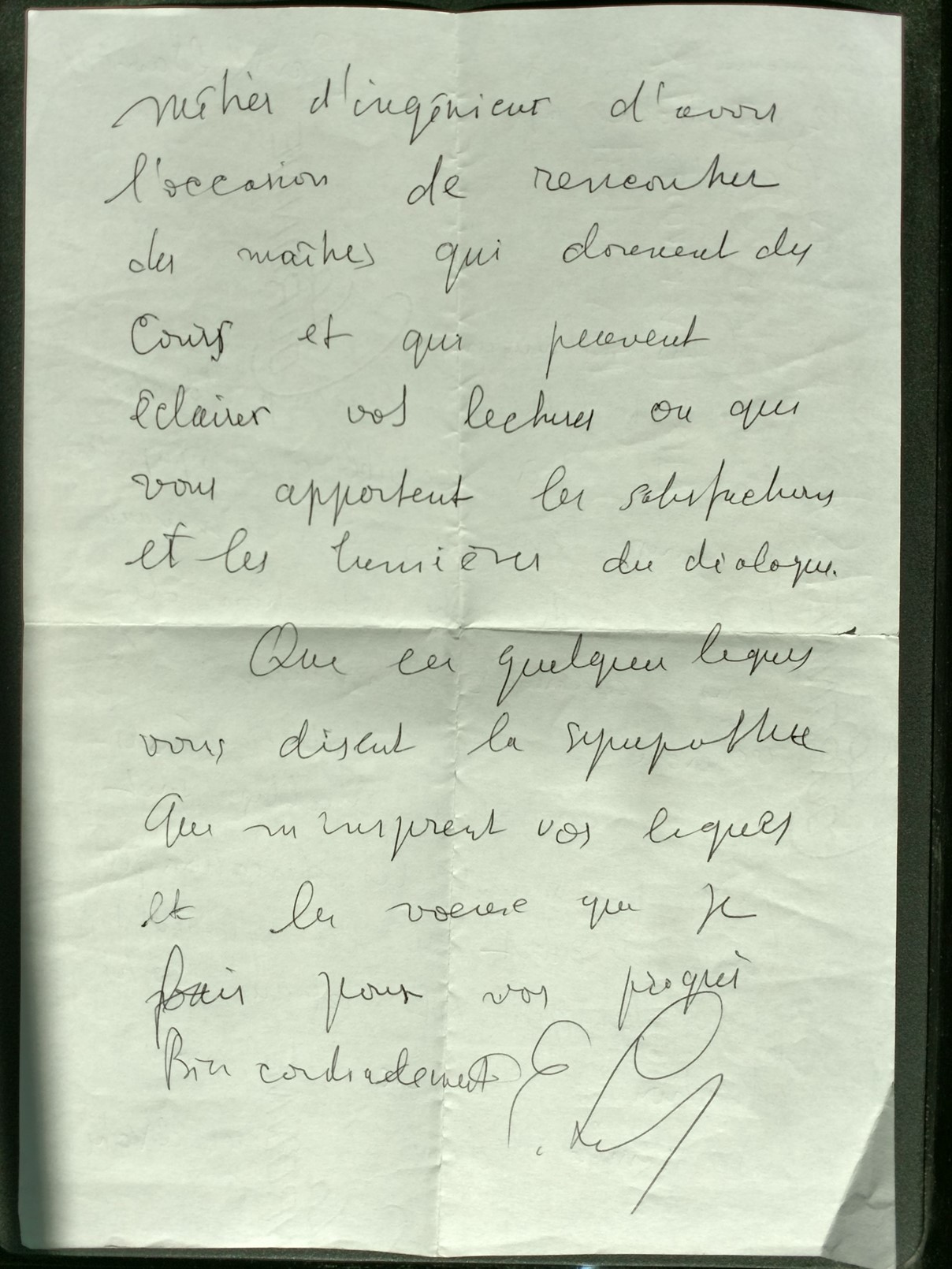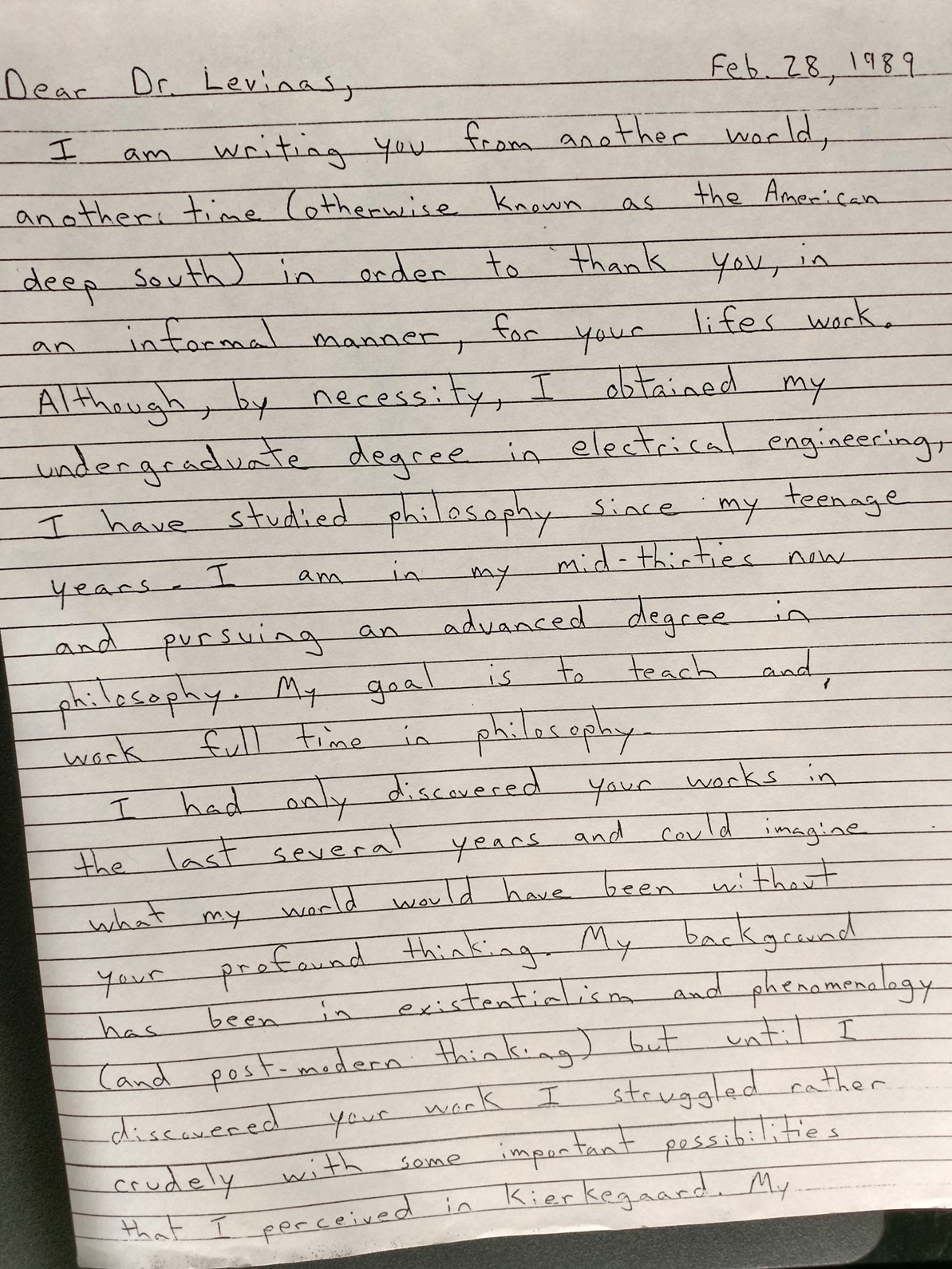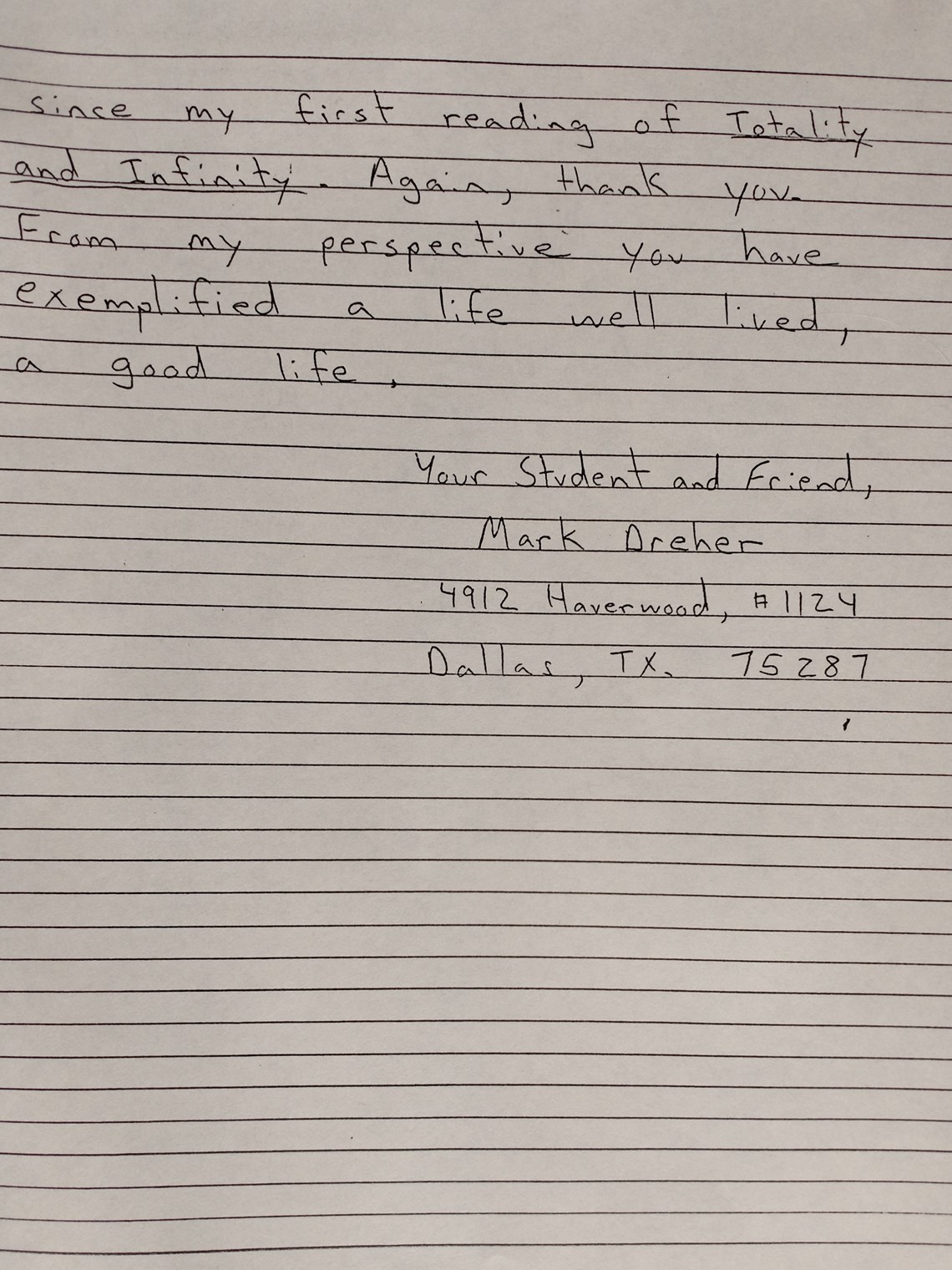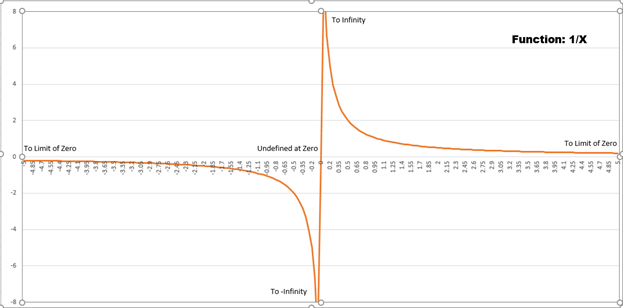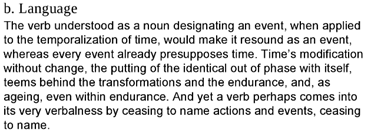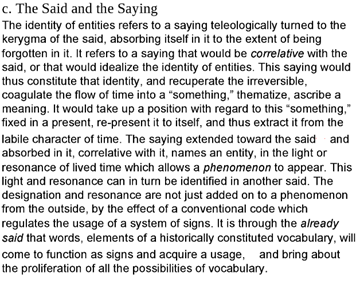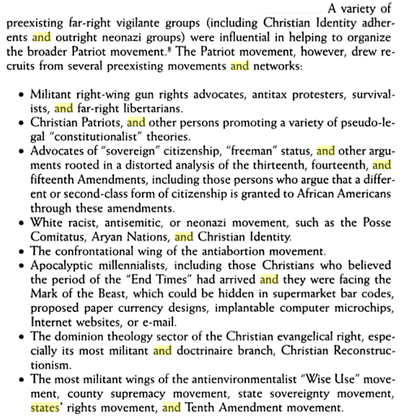Chaos Theory is:
“When the present determines the future, but the approximate present does not approximately determine the future.”1
In the Part One discussion we discussed the function 1/X. We saw cases in the function of infinity as X goes to plus and minus infinity. We also saw the case where X = 0 and the result is indeterminate. All the points except zero demonstrate a continuous, nonlinear function. That is, all real numbers in the graph is a smooth curve with no breaks or discontinuities except at zero. At X= 0 the function is discontinuous. This function simply demonstrates how we can get a degree of closure even when we entertain the notions of infinity and indeterminacy. Both infinity and indeterminacy tell us that even in the most banal circumstances such as the function 1/X we have a degree of certainty while at the same time entertaining notions where we can’t get absolute closure. Even more, these odd notions tell us that even such banal certainties are ruptured through and through with exteriorities which cannot remain in themselves but indicate an other which mathematics has no answer. In this part of the discussion we will explore further the complications which can only indicate the limits of our logic and the value of the questions these limits pose.2 The last footnote of my recent post On Origin ask this question:
Does chaos theory in contemporary science relate to radical otherness? If so, how? What about the implications of quantum theory and Schrödinger’s cat in the box? Does the uncertainty principle and the apparent malleability of what ‘is’ determined by observation have anything to do with radical alterity and the retreat from the face of the Other? More succinctly, do we face an ‘Other’, a radical alterity, even in the ‘it’ of physics?
This post will try to address this question and contrast its implications with what I consider to be a formidable philosopher whose influence has become a focal point and an anchor, both in its affirmation and negations, for the retreat from the face of the Other – Georg Wilhelm Friedrich Hegel.
For classic physics most notably represented by Newton, absolute time and absolute space is assumed. Underlying much of classic science and philosophy, causality is absolutely assumed. Causality is often associated with the billiard ball metaphor. When the cue ball hits other balls on the table, geometry and force absolutely determine the path of all the other balls. While causality may provide useful information in our everyday world, these notions have been antiquated by a much more precise understanding that spans phenomena from billiards to cosmological physics. Relativity supersedes Newtonian physics. Relativity is orders of magnitude more accurate even in the specific frame of reference which Newtonian physics works including billiard balls. However, relativity has some limitations. Relativity works extremely well on large scales but not on extremely small scales. For extremely small scales quantum mechanics is highly accurate. In special conditions, Einstein’s equations punched holes in the continuity of time-space. In a similar way that our mundane function of 1/X contains examples of infinity and indeterminacy, Einstein’s findings predicted such phenomenon as black holes and wormholes.
Einstein was responsible for pioneering quantum mechanics when he discovered that light had both the characteristics of a particle and a wave. After all he had already demonstrated that energy and matter, like the particle and the wave, were two different states of the same thing – E= mc2 (i.e., think of water as liquid or ice where heat, or the lack thereof, determines the state…for matter and energy the speed of light determines the state). However, when quantum mechanics theorized the phenomenon of entanglement, Einstein called it “spooky action at a distance”. Entanglement happens where one particle influences its twin, irrelevant of the distance between them, instantly (i.e., faster than the speed of light). Einstein’s theory of relativity could not allow anything faster than the speed of light. He thought that everything from the very large to the very small must propagate through fields setup by space-time distortions. The physicists of his day also started discussing the ‘uncertainty principle’ and ‘waves of probability’ which he vehemently disagreed. His lifelong search for a ‘unified field theory’ which would unite electromagnetism (and the strong and weak nuclear forces) and gravity suggests that continuity was paramount for him. In addition, he is famously quoted as disparaging the quantum mechanics of his day suggesting the “God does not place dice with the universe”. However, when the universe plays dice with itself, we call that ‘Chaos Theory’. Chaos as discontinuous and probabilistic, just as the budding of quantum mechanics in is day, was a philosophy Einstein might not have held in high regard. Interesting enough it was Albert Einstein that stated, “As far as the laws of mathematics refer to reality, they are not certain, and as far as they are certain, they do not refer to reality.”
Chaotic systems permeate our everyday world. Weather, turbulent water, health sciences, road traffic, sociology, physics, environmental science, computer science, engineering, economics, biology, ecology, the stock market, our brain states, philosophy and temperature are examples of chaotic systems. Almost everything in nature is a chaotic system. Chaos theory is famous for the ‘butterfly effect’ introduced by one of the founders of chaos theory, Edward Lorenz. The butterfly effect informs us that the exact path and time of a tornado may have been started by the flapping of a butterfly’s wings weeks earlier on the other side of the planet. When initial conditions can be specified to a high degree, Newtonian physics works great on a highly restricted system. As initial conditions become more critical, like the real world, chaotic systems become more prominent in relativity and quantum mechanics. Two black holes orbiting each other exhibit a highly chaotic system. There is even a branch of physics called Quantum Chaos3. Mathematically, chaotic systems are always fractals. Fractals occur when real number math (fractions) feedback into the initial conditions of a system. Fractals are the result of simple patterns being repeated infinitely by positive feedback with ever changing initial conditions. Chaotic systems are not random, but they can predict the relative probability of randomness. Chaotic systems are always non-linear and deterministic. Chaos theory is deterministic in that it surmises that if the exact initial conditions of a chaotic system is known, the exact effect of the system could be known. However, chaotic systems also state that the complexity of a chaotic system makes knowing the exact initial conditions a practical impossibility. In effect, determinism is an ideal of a chaotic system which can never be proven only assumed. As the mathematics of chaotic systems, fractals, tell us, the infinite variation of input conditions provided by positive feedback of the system make practical determinism impossible. Additionally, uncertainty increases over time in a chaotic system. In practice, chaos theory always has a degree of indeterminacy. Additionally, the assumption of cause and effect is inherent in determinism but also remains as an ideal of chaos theory not a practical reality of chaos theory. It is highly likely that quantum mechanics influences chaotic systems. Quantum mechanics is proven to be indeterministic. This is due to Heisenberg’s uncertainty principle which shows that fundamental properties of a particle cannot simultaneously be known like the position and momentum of the particle. Since quantum mechanics certainly plays a role in chaotic systems, we can draw the conclusion that chaos theory is indeterminate in practice. Therefore, chaos theory highlights relative degrees of indeterminacy and infinity while producing useful results in the output of chaotic systems.
Chaos theory is a scientific principle describing the unpredictability of systems. Most fully explored and recognized during the mid-to-late 1980s, its premise is that systems sometimes reside in chaos, generating energy but without any predictability or direction. These complex systems may be weather patterns, ecosystems, water flows, anatomical functions, or organizations. While these system’s chaotic behavior may appear random at first, chaotic systems can be defined by a mathematical formula, and they are not without order or finite boundaries. This theory, in relation to organizational behavior, was somewhat discounted during the 1990s, giving way to the very similar complexity theory.4
The reasons chaotic systems can tend towards more chaos over time or fundamental transformation is due to the ‘strange attractor’. Researchers Briggs and Peat tell us:
Evidently familiar order and chaotic order are laminated like bands of intermittency. Wandering into certain bands, a system is extruded and bent back on itself as it iterates, dragged toward disintegration, transformation, and chaos. Inside other bands, systems cycle dynamically, maintaining their shapes for long periods of time. But eventually all orderly systems will feel the wild, seductive pull of the strange chaotic attractor.5
When a strange attractor encounters another chaotic system, it pulls the chaotic system toward a wildly different result. The strange attractor essentially changes a chaotic system. Thus, butterfly wing turbulence can cause a tornado on the other side of the earth weeks later. The strange attractor transforms the chaotic system into something other than what it could be from its own intrinsic properties. The chaotic system’s self-identity is fundamentally altered by the stranger, the Other.
For Newton, time and space were pre-conditioned by Descartes mind-body split. These notions originated in a particular Latin reading of Aristotle. ‘Body’ was substance in this reading. Over time substance took on the characteristic of mechanism. The universe was thought as a machine. Causality was an important underpinning of a lifeless machine. The universe operated obliviously to mind. Just as the ancient Greeks thought the earth was the center of the universe, mechanical causality taught us the we were immersed in a sea of dead ‘things’. The radical other of Newton was alien and followed its own mechanical rules absolutely. In philosophy we would say that a certain, already understood ontology of the universe (a historic-linguistic understanding of the being of the universe), guided even our possibilities for how we could think of everything not us, not mind. This ontological setting guided science and philosophy for centuries. Even the greatest thinker of German Idealism, Hegel (18th-19th century philosopher) was guided by the notion of mind and object where object was simply thought as an idea of mind. From this discussion, what have we seen about the direction of science since Newton?
Einstein has taught us that the universe is not oblivious to body. Time and space are permeable to an incredibly sensitive degree to the mass and speed of everything from galaxies, our bodies and anything with mass. Each one of us is enveloped in our own time and space given by existence [see On Origin]. If our body does our mind as Nietzsche thought, we find that the metaphor of chaos is closer to life than mechanism. We find on the smallest quantum level that indeterminacy, uncertainty and rupture determine ontology not absolutes (such as time and space). We are not immersed in a sea of ‘things’ but participate in intimate cooperation with a ‘what’ we still do not have the language and history to inform our outdated ontologies, our understanding of what we can only name as ‘Being’ harkening back to a once upon a time which no longer exists. We know that infinity was our historic clue that we covered over with certainties and determinacy. Yet, even as Descartes would tell us the thought of infinity overflows itself, it does not remain in itself, it ruptures even the ‘is’. As far back as Hesiod, we have the trace that the force of our misunderstanding had to covered over.
As I have discussed in On Origin, Hesiod’s chaos cannot even yet think itself to be neutrality, the ‘it’. The anonymous was not as easy to come by in Hesiod’s day. Only with the subsequent weight of a history yet to come after Hesiod, can the rupture take on the neutrality of anonymity. The post On Origin attempts to think through some of the ways the ancient Greeks might have tried to cover over Hesiod’s chaos. It also inquisitively tries to find a placeholder in chaos for what Levinas would tell us is the face of the Other. It seems to me a face of a ‘he’, a ‘she’ and even an ‘it’ does not draw on the history and language which misunderstands chaos as night, void, horror, anonymity, Idea…the ‘otherizing’ of the Other, etc. but can only evoke in proximity to the Other, to an infinite transcendence which faces us, the absolute primacy of Ethics. The universe of the ‘same’ as the other is not a flight from fear but a response to awe and wonder. Not until the absolute, un-determinate, chaos has a face can Ethics take the place the ancient Greeks intuited but relegated to the logos and physics (phusis) as neutered. In the radical rupture of the Other we do not ‘see’, we feel a past which we never knew, a time and space which was never ours. We can only wonder if there was an excess which we never accounted for, saw, or understood when she spoke to us, when he faced us – when it was a place or time that lingered long afterwards. And, instead of letting the retreat to the once ‘said’, the memory understood, the place and time resolved by mere extension and ticks we can choose to place Ethics in the fore as the only remnant of the infinity we never knew but glanced in proximity from an Other not us, not me, not mine…a ‘not’ which can remain indeterminate but cannot be ignored.
Addendum:
Here are the question I would pose to Hegelians:
How is it possible that an “Encyclopedia of Philosophical Sciences” would omit the sciences since Newton’s absolute time and space? How can we suggest that science implies absolute time and space, absolute causality and absolute self-determination? If anything, the sciences since Hegel tell us that the universe is permeable on the most intimate and personal scale. Our very existence as bodies with mass and movement shapes and forms a very personal time and space uniquely ours. The universe intimately dances with us to the point of creating own unique ‘time-space bubble’ [see On Origin]. Not only that, but there are others, strange attractors, which interrupt the chaotic systems of body-doing-mind. How is it possible that Hegel’s Logic would not formally account for the essential, un-mediate-able, idea of uncertainty, indeterminacy and essential rupture of self-determinacy by the Other which is not me, whose temporality is not my time, whose spatiality is not my space? Is it with the skepticism of nothingness?6 Is the evocation of the Other “nothingness”? Does the Idea reduce the Other to “nothingness”? Don’t the sciences counter the ‘Absolute skepticism’ and ‘nothingness’ of the infinite Other thought by Hegel’s Idea? Perhaps ‘nothingness’ is the final solution for anything other than Hegelianism. How does infinity and chaos relate to the hierarchy of the ‘higher standpoint’, the self-identity of the object and absolute knowing? For Hegel, isn’t Being thought in the same ontology as that of an object to Idea? For Hegel isn’t Being ‘pure knowing’ which is ‘pure indeterminateness and emptiness’ and merely thought of as the opposite of ‘pure nothing’ which is ‘complete emptiness, the absence of all determination and content’. Hegel tells us that Being and nothing are identical. The mere thought that Being and nothing are opposites gives rise to becoming but how can ‘thinking’ think the thought of opposites in ‘pure indeterminateness and emptiness’ in the absence of content? What is ‘pure knowing’ without content? Might we think that at the very beginning of the “Logic” thinking has the same invisible inflections bending inward as the thought of a ‘thing’. Isn’t the thought without determinations or content an unspecified filler which functions as the thought of a ‘thing’. As such, don’t we recreate the dilemma of Descartes? Ah, but the Hegelians will surely protest that the ‘Logic’ is actually a circle and there is no starting point or end, but rather a totality. If so, is the starting point irrelevant? Why would Hegel disingenuously start the “Logic” with the ‘thought’ of Being and nothing while telling us the first stage has no content and no determinations but, apparently has the thought that Being and nothing are opposites? Are we to overlook this apparent contradiction for what will come later in the “Logic”? Doesn’t Being ultimately answer to the Idea, the Begriff as the ‘object’ of Begriff? For Hegel, certainly we can’t suggest that the idea of chaos participates at the highest level of absolute knowing as the truth of every mode of consciousness? Can the Hegelian Idea un-fixate its Medusa-like gaze to give the proximity of Ethics an Other which is not an object of Being but an infinitely strange attractor which Idea cannot subsume within itself? What relevance shall we give to the idea which holds itself off, which gives itself its own essential limitation on the possibility that it may not be absolute but self-delusion which has an ultimate, world historical reason, for effacing and fleeing from what it can never ‘know’ but only encounter in the ‘he’, the ‘she’…and the ‘it’ which science informs us is not the ‘it’ we thought as ‘was’. The question is not ‘to be or not to be’ or even ‘why is there something rather than nothing’ but why is there ‘Other rather than nothing’?
Here are my unedited answers:
Thinking for Hegel is existential.7 Thinking is only allowed to think from the structure of his dialectic. Hegelianism is the autopsy of Idea in the region of the absolute. Hegelians seem to have almost have a gym-rat type vibrato about thinking the Thought. What are the building blocks of Hegelianism in the Thought of the Absolute? First, Hegel takes on the mantle of Totality driven by the Absolute – the science of his day. Certainly, the dialectic of Hegel assumes structure – hierarchical structure. Hegel’s claim to the circularity of his hierarchy does not undo the hierarchy but indemnifies it from temporality. In this way, he positions his structure as constitutional, as immortal, the ‘definition’ of human. Determinism is paramount for Hegel. Even the indeterminate must take a back seat to the Idea even at the first movement of the Logic (Being-Nothing previously mentioned). Any exterior to his definitive and determinative structure is relegated to ‘nothingness’ as Hesiod’s chaos was dispensed with the nothing of ‘night’ and ‘void’. Determinism is undergirded by the absolutism of cause and effect, the billiard ball approach, from the science of his day. Absolutism requires certainty. A machine must be capable of reverse engineering. Hegel has disclosed the structure of the human machine. The mechanical metaphor reigns supreme in Newtonian physics. One thing Hegel shares with current science is the assumption of progress. The move of Spirit will eventually unearth the mind of God which will be Hegel’s “Logic”. However, the difference in an absolutist structure and the relativity of uncertainty is the loss of discovery. Hegel has precluded any possibility for essential progress. Sure, work can be done ad infinitum to flesh out his superstructure but the System as ‘almost complete’ is meant with ‘almost’ meaning the perpetual fleshing out of his Idea. We should also notice that Hegel’s structure includes the existential (existentiell). As in Heidegger’s Ontic-Ontological structure, we have Hegel’s idea-Idea. All thinking and thoughts must forever suckle at the Idea. In this dynamic we have uncovered the power structure. Hegel’s master-slave paradigm is the dynamics of power relations. In thinking strictly and totally within the machismo-ridden structure of the Logic we have the master, Hegel, and the slave, his career driven philosophers. Hegel’s devotees are in servitude to the strict demand of obedience to the Logic lest they incur the penalty of falling into nothingness, the heresy of the strict confines of the Logic. Is it inconceivable that the slave could ever claim the right to freedom and cast off the yoke of Logic? Hegel even goes so far as to try to convince us that his Logic cannot be criticized. Since the Logic is absolute in its determinations anyone who criticizes it must be themselves deluded and thus irrelevant. All of this has the effect of isolating the Hegelian academics from any exterior which might try to update ‘The Science’ beyond Newton. The last assumption of Hegel’s super structure is denial of the other. Science is often criticized by philosophers as coming too late with too many assumptions. As such it is relegated to the ‘technician’ level of philosophical science. Hegel’s Logic is built upon the dogma that there is no exterior to the Logic. At least the philosophically deprecated sciences have the foundation of an other which is not understood. In servitude to Hegel the slave cannot admit any exterior. His economy is an absolutely restricted economy dictated by the master and his servitude to the abstraction of his existence. The master-slave dynamic can either break down or the slave can become yet another master with, according to Hegel, the added benefit of concrete existence from having been the slave. However, after a while, wouldn’t the slave forget his ‘authenticity’ and find himself equally abstracted from his existence as is to be expected from the master according to Hegel. The slave can never really escape the master-slave dilemma except in the freedom of abstraction. Thus, exteriority is forever denied. I guess it comes down to an Ethical decision. We can decide to take up the mantle of apostacy and decide that there is exteriority which cannot be subsumed into the totality of the same and thereby, discover an Ethics which is not altruistically derived from duty or Logic. When the radical rupture of the face of the Other is exterior to me, to the ‘said’ of language, Ethics is choice over necessity to the ontological or ‘Logic’al idea even as subjectivity is substitution from infinite responsibly.
_________________
1 Lorenz, Edward Norton (1972). “Predictability: Does the Flap of a Butterfly’s Wings in Brazil Set Off a Tornado in Texas?” Address at the 139th Annual Meeting of the American Association for the Advancement of Science, Sheraton Park Hotel, Boston, Mass., December 29, 1972.
2 In the previous discussion there is a graph which maps out in two dimensions the function 1/X where X varies from minus infinity to plus infinity. We can see from the graph that at the ‘zeros’ of minus infinity and plus infinity the function goes to zero. Note that while the limit of X at both infinities is zero, the function never reaches either zero as infinity is an ‘ideal’ of real numbers not anything which we could call ‘real’. Also, note that as X approaches zero from either zero the graph of 1/X approaches negative infinity to the left of zero and positive infinity to the right of zero. Likewise, in this case, as X approaches zero the result of the function goes to infinity of either side of zero. In either case, the fraction part of these real numbers needs ever arrive at its destination of zero. The approach to plus and minus infinity at zero we call ‘poles’ [See Pole–zero plot for more details]. However, at zero the result of 1/X is called undefined. What this means is the vertical line of the function on the graph at zero does not exist. We have a boundary condition at zero where the function makes no sense [Division by zero]. There is no number that satisfies the result 0 1/0. For example, if you have 1/1 you could think of it as dividing 1 cookie into 1 part which would be the whole cookie. However, in the case of 1/0, the divisor makes no sense if you want to divide one cookie into zero parts. The result of 1/0 cannot result in a number because the question posed by the function makes no sense. The function 1/0 exemplifies what I will call indeterminate or a singularity [See Singularity (mathematics) for more details]. The math makes no sense at zero for the function 1/X. For all X in our function except the point at zero, this is what mathematics calls a continuous function. In relativity, gravity is a continuous field. So, what does this mean for the purpose of this discussion?
What I am trying to flush out of this example is that we have a mathematical ideal which gives us some closure (recall the part 1 discussion about closure) around the function 1/X. We have concrete definition about the ideal behavior of 1/X. We can know much about the function’s behavior around the poles of zero. However, at the boundary condition of zero our ideal mathematical language makes no sense. The ideal language we are using breaks down, almost imperceptivity at an infinitesimally small point where X=0. We could say that the negative of the side where X is less than zero is the right side of the graph because -1 times (1/X) where X is always negative will always be positive like the graph where X > 0. Thus, the negative corresponds to a positive term, i.e., the right side of the graph. In fact, the negative of X< 0 OR X> 0 is simply a restatement of X> 0 OR X< 0 respectively. The negative is an absolutely necessary condition to satisfy the essential requirement of the function. Without the negative the function could not be posited. In this sense, X< 0 and X> 0 are absolute, dialectical opposites. They are absolute as they mirror each other in their opposition, their negation. At the same time, they also categorically define the function on both sides of X = 0. In effect, we have set up an absolute opposition between thesis and its absolute other, the negative, antithesis, and lifted them up as both inclusive and exclusive of each other without reserve…in a hermitically sealed closed relationship. What we have done is asserted a positive term or function X> 0 OR X< 0 and its negative X< 0 OR X> 0 respectively, literally what it is and what it is not. This is a multiplicative inverse or reciprocal relationship. The result of this operation is to deny, by definition, any possible exterior. Since this mathematical example is a very isolated situation by design, I do not want to generalize it as example of all Hegelian dialectics and thereby try to indict Hegel. I have come to see that the triadic (thesis-antithesis-synthesis) is an over simplification of Hegel’s project. However, I do want to pose this very isolated question, is it possible to think the negations discussed above as a specific and formal case of one type of a determinate negation (bestimmte)?
What can we make of the boundary condition of X = 0? We could take advantage of undefined, the absolute rupture at zero, by suggesting the 1/0 = 1 but then, according to division’s inverse property 0 X 1 would have to equal one – a contradiction. Basically, any possible number or relationship can be posited in the boundary condition. At the boundary of zero we could say that the boundary contracts or joins all other values of X OR we could say that the boundary condition alienates or separates all other values of X. Since this mathematical example is a very isolated situation by design, I do not want to generalize it as example of all Hegelian dialectics and thereby try to indict Hegel. However, I do want to pose this very isolated question, is it possible to think the negations discussed above as thesis and antithesis and the boundary condition as a synthesis, what Hegel called aufheben or sublation? Is it possible that the necessity of the dialectic drives the function 1/X?
“Malabou argues, ‘Dialectical sublation proceeds through a movement whereby, at one and the same time, it contracts and alienates the material on which it acts’. The Aufhebung is not simply the one that brings together the one and the multiple, but also the multiple that holds apart the one and the multiple; it is the identity of non-identity and identity and the non-identity of identity and non-identity. In Jameson’s words, ‘dialectics are dialectical’.” Aufhebung and Negativity: A Hegelianism without Transcendence, Ryan Krahn, University of Guelph
If so, the aufheben becomes a restricted economy which ‘contracts’ (combines) and alienates (excludes). By restricted economy I mean sets up all possible conditions under which anything can be said, thought, asserted or denied of the function 1/X. When the boundary is thought as aufheben there is no possible exit from the dialectic. Of course, we could say that the boundary is indeterminate. We could say that the boundary is a rupture, a radical alterity, with regard to the whole system of mathematics. Would these assertions be an escape altogether from the dialectic we have constructed? If we assume that mathematics is the only possible field where any possible objection can occur, then these objections are meaningless. If the notion of rationality as the only possible field is substituted for mathematics, then these questions can only be answered in the restricted economy we have set up. We have set up an absolute, closed system, which can never exceed itself. There can be no radical rupture. The effect of this is to close out all other possibilities in a restricted economy thus absolutely removing the possibility that the boundary is indeterminate. It is an absolute denial of all possibilities for a radical other. However, the denial is not in the asserted boundary condition but in the repetition of the thesis in the antithesis. The other was already made impossible by the repetition not from anything surreptitiously brought in at the boundary, the synthesis. This movement is what we now call totalization.
Let’s think about the approximation we thought about with the ‘tendency towards closure’ and the ‘opens towards an unbridgeable tear’.As opposed to the hermetically sealed which can recognize no other, the ‘tendency towards’ is the empirical. The System is deduction while the ‘tendency towards’ is inductive. It is also the difference between certainty and contingency. In approximation, we discover qualities around infinity which provide a degree of closure. The yawning gap of chaos is smoothed over by the mathematics of infinity, calculus. The radical alterity of the Other is tamed by common sense. We form ideas about the Other. Levinas calls these plastic casts we throw over the face of the Other. We have theories with relative degrees of accuracy for prediction. We think of the Other as the ‘same’ as us as a desirable idea. We think of diversity as a collection of Other’s which is also desirable. When we think conventionally as the other being negative, ‘otherizing the other’, we think of the other as alien and evil. However, the alien and the evil are our idea of the other. The idea of the other is yet not the other even as the idea of Hesiod’s chaos never arrives at its destination. In all these cases we have applied ready-made inductions to level out and retreat from radical rupture…the infinity which looks at us in the face of the Other and in the very notion of infinity.
From Part One of this discussion, let’s recall the paradox. We have the notion of a mathematical point which is infinitesimally small. Therefore, a ‘real’ point is an impossibility. However, relativity physics tell us that a black hole results in a singularity. In addition, according to relativity, if we follow cosmic history back to the big bang, all the matter in the universe coincides into a singularity. It is as if we backed up into the other side of a black hole. A singularity is a radical rupture in time-space. It is also indeterminate. A singularity is in effect a division by zero [Division by zero]. Is the “Beginning of Time” a myth? [The Myth Of The Beginning Of Time, “The Myth of the Beginning of Time”, A Matter of Time, SCIENTIFIC AMERICAN, January 2012, Volume 306, Issue 1s] By ‘myth’ in this discussion we do not mean ‘not ‘true’ we simply mean impossible. The myth is the singularity of the black hole or the big bang that relativity would tell us. For Hesiod, the beginning starts with a myth and a paradox.
Let’s think of Hesiod’s myth as the story we tell ourselves like the story Einstein tells us in relativity (although they are obviously not the same). Let’s think of Hesiod’s chaos as the radical rupture we think in singularity. The story we tell ourselves is quite convincing. However, no matter how carefully we trace our steps back to the origin we find we are left with an indeterminate difference. The difference is demarcated by the myth and the rupture. In fact, might we think that the myth is a retreat from an impossible singularity, an alterity that tears at the nexus of the contradiction of paradox which cannot be true but is true. The myth must be mute with regard to the paradox. The muteness we call indeterminacy. Of course, in our time, physics has competing theories about how Einstein’s singularity can be eliminated. However, none of those theories have the extremely accurate predictability of relativity on a very large scale. They also have their own resurrections of paradox which is not the subject of this discussion. At the same time, quantum theory is highly accurate on a very small scale. To date, we have not found a proven way to unite the very large and the very small. In this discussion I will not attempt to deal with the vast paradox’s which quantum theory intriguingly brings to the fore. Of course, we can always simply ignore the rupture with eternal positivism for a future resolve of the large and the small, a myth that will finally be the “theory of everything” or as Hegel thought, the ‘System’. If the history of myth is any precedent, the promised myth will also arrive with its own tears in the fabric of, shall we suggest, ‘what is’. As Levinas reminds us,
“in thematizing we are synchronizing the terms, forming a system among them, using the verb to be, placing in being [the myth] all signification that allegedly signified beyond being [for the current discussion chaos]? Or must we reinvoke alternation and diachrony as the time of philosophy? … Philosophy is not separable from skepticism, which follows it like a shadow it drives off by refuting it, again at once on its footsteps. Does not the last word belong to philosophy?” [Emmanuel Levinas, Otherwise than Being or Beyond Essence, trans. Alphonso Lingis (Pittsburgh: Duquesne University Press, 1998) , 167, 168, 169. Also Cited by Richard A. Cohen in The Face of the Other, Ethics as First Philosophy: Two Types of Philosophy in the Thought of Emmanuel Levinas , Delivered as keynote address on August 1, 2013, at conference on “Culture and Philosophy as Ways of Life in Times of Global Change,” School of Philosophy, University of Athens, Athens, Greece, pg. 11]
The diachrony of the time of philosophy and history covers over its own ‘geological faults’. It tells us the System is almost complete. Chaos will be discarded, the paradox resolved, the Gordian knot untied. However, every new myth cannot seem to rid itself of the infinites which face us. Skepticism refuses without falling into the void it stares into. Skepticism is the last tragic stand of the hero which can no longer assert anything but its end. In this situation philosophy (and science) must forever drive off the shadow, the night, the void, nothingness to retreat from the abyss. The radical tears in Being and ‘is’ punctuated by death yet, still covers over the absolute intolerability of chaos. Hesiod’s chaos has no face. As such, it is the ‘horror’ of indeterminate-ability of the ‘there is’ which cannot be, the il y a.
“Being, as we noted, also is dark indeterminacy. Having suspended the binaries of de facto inside and outside as part of his own phenomenological bracketing, Levinas will approach this indeterminacy not as objectivity, but as something revealed through mood. Whether it is the dark indeterminacy that besets the insomniac self, or whether it is the rustling of nocturnal space, Being’s dark aspect horrifies us. “The things of the day world then do not in the night become the source of the ‘horror of darkness’ because our look cannot catch them in their ‘unforeseeable plots’; on the contrary, they get their fantastic character from this horror. Darkness…reduces them to undetermined, anonymous being, which they exude”. This anonymous being, also called the il y a [there is], does not ‘give’ the way Heidegger’s Being does. And it is not revealed through mere anxiety. Nevertheless, it is a beginning. Insomniac and in the throes of horror, the hypostasis falls asleep. Or again, it lights a light and reassembles its consciousness. It “sobers up.” Therein lays our first, constitutive escape from neutral Being. But the il y a gives the lie to the question: Why is there Being instead of simply nothing? Nothing, as pure absence, may be thinkable, but it is unimaginable. Indeterminate Being fills in all the gaps, all the temporal intervals, while consciousness arises from it in an act of self-originating concentration. This is the first sketch of Being as totality. The self-‘I’ dyad becomes a limited transcendence arising in the midst of the self’s encompassing horror. It hearkens to a call that comes not from neutral Being but from the Other. The stage is thus set for Totality and Infinity’s elaborate analyses of world, facticity, time as now-moment, transcendence in immanence, and transcendence toward future fecundity. These themes constitute the core of Totality and Infinity: An Essay on Exteriority.” Emmanuel Levinas
5 Turbulent Mirror: An illustrated Guide to Chaos Theory and the Science of Wholeness, Briggs and Peat, 1989, 76-77
6 “the skepticism which only ever sees pure nothingness in its result and abstracts from the fact that this nothingness is specifically the nothingness of that from which it results.”…”the skepticism that ends up with the bare abstraction of nothingness or emptiness cannot get any further from there, but must wait to see whether something new comes along and what it is, in order to throw it too into the same empty abyss.” Phenomenology of Spirit [Phänomenologie des Geistes], translated by A.V. Miller, Oxford: Oxford University Press, 1977, §79.
7 Thinking is Idea in time. Here is how that works out in Hegel. Space is the negation of Idea as Concept. Concept (Begriff) is not ‘seen’. It does not undergo contingencies. Concept itself has no time or space (external to itself) except in the ‘timeless’ dialectics in which space and time arises. However, the negation of Concept is space. The negation of space is the point. The point is time. Becoming as mentioned in the post is the ‘now’ moment (which oscillates between Being and nothing) where all points in space negate themselves into a single moment, the present. Hegel understands space as three dimensional as Newton also did. Since time negates space, it collapses space into a zero dimensional point. Human time is the negation of the anonymous point (which is nature’s time) and passes into ‘recollection’. Recollection refers to the past and the negation of the past is the future. The now is the in-between, the aufhebung. The time-self’s negation is Concept. This completes the circle where all dialectics are fulfilled in Concept. The dialectical oppositions and sublations are preserved in Concept. Concept is completion and determination. According to Hegelians, Concept is totally within itself, driven from its own dialectics without externality (not already accounted for in its dialectical movements). Thus, the critique of my post with regard to the indeterminate, chaos, uncertainty are reduced to dialectical movements and subsumed by the absolutism of the Newtonian science of Hegel’s own ‘Now’ moments. Understanding Hegel’s Theory on Time Note: It is interesting that Concept itself can be negated. I suppose Concept’s time-space-lessness opposes itself in the other of space opposing itself as time, etc.. In this particular case, Concept, itself has an other (dare we think as externality?) . A Hegelian would probably tell us that the ‘other’ of negation is not an external other but an other driven from within the Concept (in this case) as its depleted mode (in a sense). So, therefore, space is not other except in thought (as was the case with Being and nothing). Can Concept think itself? Wouldn’t that require time? Is this yet another case where thinking is merely assumed as was the case with Being as ‘pure knowing’ which is ‘pure indeterminateness and emptiness’ and ‘pure nothing’ which is ‘complete emptiness, the absence of all determination and content’ that already has the thought of their opposition.
